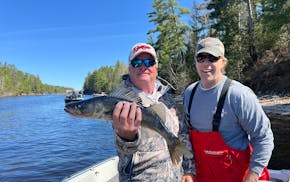When Dane Nelson paddled his kayak onto a Minneapolis city lake June 16, he didn't know he would catch a 51-inch muskie. But Nelson, of Minneapolis, a long-time muskie angler, thought he might.
The same is true for Jake Skarloken, who had canoed into Crooked Lake in the Boundary Waters Canoe Area Wilderness for more than 20 years before catching a 47 ¼-inch northern pike May 23 that likely would have been a Minnesota catch-and-release record if he had taken photos of its length and girth measurements.
Skarloken opted instead to return the fish to the water as quickly as possible, to ensure its survival.
Nelson and Skarloken's confidence in 2024 that on given forays onto Minnesota lakes they might catch a fish of a lifetime is testament to the state's bountiful angling opportunities.
This is especially true given Nelson's whopper was landed within sight of the Minneapolis skyline, while Skarloken's was fooled within a stone's throw of the Canadian border.
Their catches also are testament to the compulsion that draws people to fishing, and angling's place, through history, in the human experience.
Jesus's first four disciples, after all, were "brothers of the angle," as Izaak Walton described the afflicted, and from them have descended, more or less, the 1-million-plus Minnesotans and Minnesota visitors who each year toss a lure or baited hook into a state lake or river.
And who, like Nelson and Skarloken, think they might catch something.
John V. Schanken was among the possessed.
An Illinois resident who for about 50 years reigned as a Minnesota fishing celebrity only to ultimately be dethroned, Schanken in 1920 began rumbling in the jalopies of his era across northern Minnesota's rugged two-tracks in pursuit of big fish.
An outdoorsman worthy of that description, Schanken had guided moose hunters in Canada. But his claim to Minnesota fishing fame was staked in May 1929, when he and five buddies paddled into Basswood Lake in what is now the BWCAW.
On that adventure, Schanken didn't know he would catch a 49-inch northern pike that weighed 45 pounds, 12 ounces — a fish that for a half-century was recognized not only as the undisputed Minnesota record of the species, but a world record as well.
But he thought he might.
Which is why on Wind Bay of Basswood during that trip he summoned the optimism that is every angler's constant companion and tossed a Bass-Oreno toward shore. A hundred other casts might have yielded nothing. But this toss produced a monster northern that likely was photographed a day or two later, when the group had paddled back to Winton or Ely.
Assuming the veracity of Schanken's story — and as a courtesy, one angler to another, I assume it — the delay might explain the fish's depleted appearance in the accompanying image.
Yet however strong angling's attraction has been throughout history, in retrospect a watershed moment in 1955 signaled the beginning of the end in Minnesota of killing fish for no good reason.
On July 16-17 of that year, more than 160 muskies weighing between 18 and 42½ pounds were hooked, gaffed and brought to the dock at Federal Dam on Leech Lake, where they were freeze-framed alongside smiling anglers in photographs that through today's lens look like police lineups.
Elsewhere on Leech Lake at about the same time, untold other muskies were hung from bragging poles before being splayed onto cleaning tables, where their sides were filleted and skinned.
"Fantastic Fishing Spree Continues at Federal Dam Landing," exclaimed the July 21, 1955, edition of the Deer River News:
"What makes this fish story a whopper and of unusual interest which is being wired around the United States, televised, and broadcast, is the unbelievable number and size of the tiger muskies taken, and so foolishly, on the part of this massive fighter, who is striking on just about anything a fisherman will drop in the water.''
Today, thanks to regulations anglers themselves have demanded, no Minnesota muskie smaller than 54 inches can be kept.
All of which came to mind recently after Nelson sent me a photograph of the muskie he caught in a Minneapolis lake, and especially after looking at a second image that accompanied his email.
That photo — the "brag" photo of the two — showed Nelson's 51-inch trophy swimming away safely, after being released.
A dentist who doesn't have as much time to fish now as he did while growing up in Stillwater, Nelson occasionally chases muskies on far-flung lakes with a buddy in his boat.
"So I thought it was ironic," he said, "that the biggest muskie I've caught was in a kayak a few blocks from my home."
The memory of a big northern pike caught and released during a repeat pilgrimage to a wilderness lake is also prize enough for Skarloken, state record or no state record.
"All I really wanted to do was to make sure that fish swam away safely," he said. "I want to bring my kids up there in coming years and give them the opportunity to catch the same kind of fish."
And Schanken?
From the time he and his buddies returned from their trip to Basswood Lake in 1929 until 1975, when he died in Sullivan, Ill. at age 86, not one person questioned the record classification of his northern pike.
Only in 1980, when the Minnesota Department of Natural Resources began to require that fish designated as the state's biggest must be officially weighed and measured, did Schanken's trophy get relegated to also-ran status.
That's fair, I guess.
I'm just glad it happened after he died.

Anderson: In early June, Minnesota fish are begging to be caught. Won't you help?

Anderson: Tails wagging, DNR officers' dogs find lost people and missing evidence
Anderson: Punish poachers more
Anderson: The Chainsaw Sisters Saloon is gone, but the Echo Trail is still a pathway to possibilities




